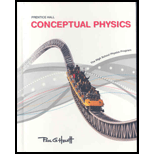
A bug and the windshield of a fast-moving car collide. Indicate whether each of the following statements is true or false.
a. The forces of impact on the bug and on the car are the same size.
b. The impulses on the bug and on the car are the same size.
c. The changes in speed of the bug and of the car are the same.
d. The changes in momentum of the bug and of the car are the same size.
(a)
To Check: Whether the given statement is true or not.
Answer to Problem 50A
True, the forces are equal and opposite.
Explanation of Solution
Introduction:
The phenomenon of action and reaction forces is describedby the Newton’s third law of motion. As per this law, object exert equal amount of force on each other.
Yes, the forces of impact on the bug and on the car are the same size because according to Newton’s third law of motion, objects exert equal and opposite forces on each other.Thus, the impact forces on the bug and on the car are the same size.
Conclusion:
Hence, the given statement is true.
(b)
To Check: Whether the given statement is true or not.
Answer to Problem 50A
True, the impulses on the bug and on the car are the same size.
Explanation of Solution
Introduction:
Impulse is defined as a product of force exerted and time of contact between the objects.
The force of impact on the bug and on the car are the same size because the same force is applied to each, for same instant of time interval.Thus, the impulses on the bug and on the car are the same size.
Conclusion:
Hence, the given statement is true.
(c)
To Check: Whether the given statement is true or not.
Answer to Problem 50A
False, the speed changes of the bug and of the car are not the same.
Explanation of Solution
Introduction:
The change in the speed depends on the mass of the objects if the applied force is same in case of collision.
The speed changes of the bug and of the car are not the same because the car does not reverse direction like the bug does. The mass of the car is very high as compared to the bug due to which change in the speed of car is negligible as compared to the bug.
Conclusion:
Thus, the speed changes of the bug and of the car are not the same. Hence, the given statement is false.
(d)
To Check: Whether the given statement is true or not.
Answer to Problem 50A
True, the change in momentum of the bug and of the car are the same size.
Explanation of Solution
Introduction:
The change in the momentum is defined as the impulse.
The change in momentum of the bug and of the car are the same size because the change in momentum is the impulse. So, if impulse are equal then the change in momentum is also equal.
Conclusion:
Thus, the change in momentum of the bug and of the car are the same size. The given statement is true.
Chapter 8 Solutions
Conceptual Physics: The High School Physics Program
Additional Science Textbook Solutions
Biology: Life on Earth with Physiology (11th Edition)
Chemistry: Structure and Properties (2nd Edition)
Chemistry: A Molecular Approach (4th Edition)
Microbiology: An Introduction
Organic Chemistry (8th Edition)
Chemistry: An Introduction to General, Organic, and Biological Chemistry (13th Edition)
- Example Two charges, one with +10 μC of charge, and another with - 7.0 μC of charge are placed in line with each other and held at a fixed distance of 0.45 m. Where can you put a 3rd charge of +5 μC, so that the net force on the 3rd charge is zero?arrow_forward* Coulomb's Law Example Three charges are positioned as seen below. Charge 1 is +2.0 μC and charge 2 is +8.0μC, and charge 3 is - 6.0MC. What is the magnitude and the direction of the force on charge 2 due to charges 1 and 3? 93 kq92 F == 2 r13 = 0.090m 91 r12 = 0.12m 92 Coulomb's Constant: k = 8.99x10+9 Nm²/C² ✓arrow_forwardMake sure to draw a Free Body Diagram as wellarrow_forward
 College PhysicsPhysicsISBN:9781305952300Author:Raymond A. Serway, Chris VuillePublisher:Cengage Learning
College PhysicsPhysicsISBN:9781305952300Author:Raymond A. Serway, Chris VuillePublisher:Cengage Learning University Physics (14th Edition)PhysicsISBN:9780133969290Author:Hugh D. Young, Roger A. FreedmanPublisher:PEARSON
University Physics (14th Edition)PhysicsISBN:9780133969290Author:Hugh D. Young, Roger A. FreedmanPublisher:PEARSON Introduction To Quantum MechanicsPhysicsISBN:9781107189638Author:Griffiths, David J., Schroeter, Darrell F.Publisher:Cambridge University Press
Introduction To Quantum MechanicsPhysicsISBN:9781107189638Author:Griffiths, David J., Schroeter, Darrell F.Publisher:Cambridge University Press Physics for Scientists and EngineersPhysicsISBN:9781337553278Author:Raymond A. Serway, John W. JewettPublisher:Cengage Learning
Physics for Scientists and EngineersPhysicsISBN:9781337553278Author:Raymond A. Serway, John W. JewettPublisher:Cengage Learning Lecture- Tutorials for Introductory AstronomyPhysicsISBN:9780321820464Author:Edward E. Prather, Tim P. Slater, Jeff P. Adams, Gina BrissendenPublisher:Addison-Wesley
Lecture- Tutorials for Introductory AstronomyPhysicsISBN:9780321820464Author:Edward E. Prather, Tim P. Slater, Jeff P. Adams, Gina BrissendenPublisher:Addison-Wesley College Physics: A Strategic Approach (4th Editio...PhysicsISBN:9780134609034Author:Randall D. Knight (Professor Emeritus), Brian Jones, Stuart FieldPublisher:PEARSON
College Physics: A Strategic Approach (4th Editio...PhysicsISBN:9780134609034Author:Randall D. Knight (Professor Emeritus), Brian Jones, Stuart FieldPublisher:PEARSON





